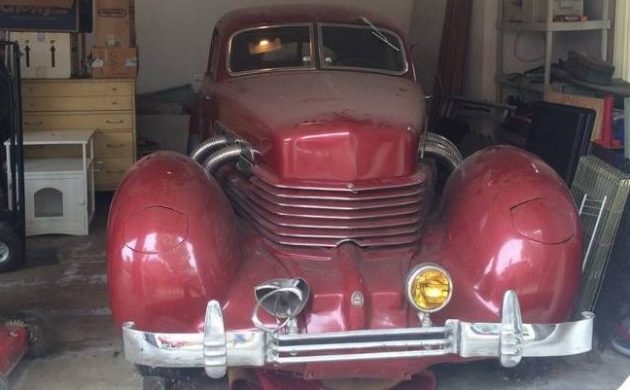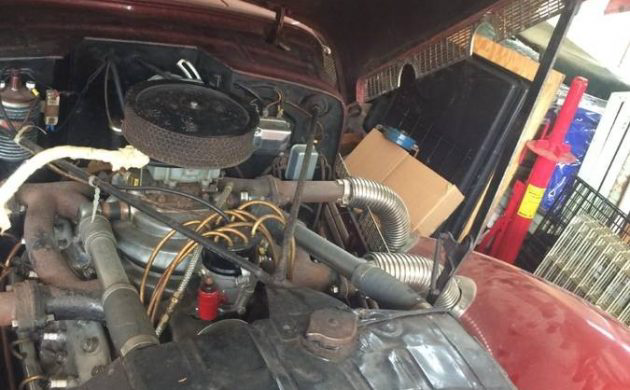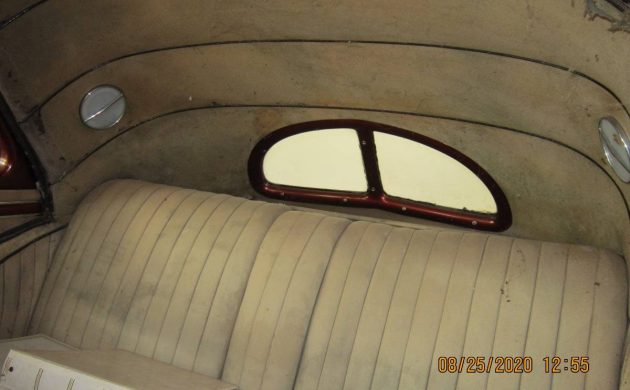Estate Find: 1937 Cord 812 Beverly Sedan
When an automotive high-flyer comes crashing back to Planet Earth, pilot error is usually the culprit. This can take many forms, but Cord was a company that managed to do the job better than most. Today, the company is a distant memory, but their beautiful vehicles do appear on the market from time-to-time. Barn Finder Ikey H spotted this 1937 Cord 812 Beverly Sedan for us, so thank you so much for that Ikey. It is being sold to settle an estate and is located in Homer Glen, Illinois. The 812 has been listed for sale here on craigslist with an asking price of $42,000.
When it was new, the 812 Beverly Sedan in supercharged form was by no means a cheap car. While the average American home in that year sold for $4,100, this car would have cost its lucky owner an eye-watering $3,060. There was the rub and one of the reasons for the car’s, and the company’s, ultimate failure. The 812 was a rebadged version of the previous 810 and was being sold into a shrinking market due to economic circumstances. The simple fact was that people who would generally hand over their cash for this car didn’t have that cash anymore. That was a shame because the car was a thing of styling beauty. Its distinctive coffin nose and concealed headlights helped to make it stand out in a crowd. It is little wonder that the 810 caused a sensation when it was unveiled at the New York Auto Show in November of 1935. It made its competition look dated and relatively pedestrian. The styling was made possible by a radical drivetrain, which gave the car a lower and sleeker appearance than its peers. This Cord has been sitting in storage for an extended period, but it isn’t clear how long this has been. It underwent a full restoration some years ago and still seems to present nicely today under the coating of dust. The paint and panels look good, and there are no signs of rust issues. All of the trim and chrome is present, and I suspect that the majority of it would respond well to some effort with a high-quality polish. There are a few issues to consider. The car has been fitted with accessory fog lights, and one of these is badly damaged. I did a brief search for a replacement but had no luck. Maybe a more concerted effort might bear fruit on that one. The passenger-side front door glass is also cracked, and this will need to be replaced at some point. If a new glass can’t be found, there are some excellent Cord owner’s clubs spread across the country. They always seem to be quite helpful and might be able to assist in this area.
The Cord isn’t numbers-matching, but its mechanical configuration is the same as when it rolled out of the factory. Under the hood is the 289ci Lycoming V8, which is fed by a Schwitzer-Cummins supercharger. This engine produced 170hp in its prime, which found its way to the front wheels via a 4-speed pre-selector transmission. This is where we unearth the second issue which helped to seal the fate of Cord. The transmission wasn’t thoroughly tested when the 810 went into production. There were issues with it slipping out of gear, along with other problems. This cooled initial demand for the 810, and it is why unsold 1936 Cord 810 models were renumbered and sold as 1937 model 812s. This drivetrain configuration was also a significant contributor to the styling of the 810/812. With no driveshaft to consider, the car could be built with a flat floor. It also meant that the whole vehicle could run lower to the ground, which accentuated the car’s flowing lines. This car is said to have been running when it was parked, but no-one seems to know how long ago this was. It will require a thorough check before any attempt is made to coax the engine back to life. I would also expect that the brakes and all rubber components will need to be inspected. However, with the storage facility looking so dry, there is a chance that this has minimized any deterioration. It’s interesting to consider that with the demise of the 1937 Cord 812, the next American car to feature front-wheel-drive was the 1966 Oldsmobile Toronado. That’s a long time between drinks for that piece of technology.
When you climbed aboard a Cord, you knew that you weren’t entering your average car. The upholstery was sumptuous, space abounded, and the quality of the fixtures and equipment was beyond question. The reality is that the interior of this 812 doesn’t need a lot to return it to its best. As you can see, the headliner is looking tired and shabby and would benefit from replacement. The remaining upholstery is in desperate need of a deep clean. I believe that attending to those issues would have the interior sparkling once again. One of my favorite interior features is the machine-turned dash. This is in beautiful condition, and still features all of the correct gauges and the original radio. That was the mark of a real luxury car in 1937. Any vehicle that featured a radio as standard equipment at that time had to be something quite special.
The Cord 810/812 faced a perfect storm. It was the wrong car in the wrong place at the wrong time. Add the reliability issues with the revolutionary transmission, and that sealed the fate of both the model and the company. Today, values have remained rock-solid. Any example featuring the supercharged engine will command a premium in the market. Good examples of the Beverly Sedan can sell for more than $80,000, but values for pristine cars can easily head into six-figure territory. With those sorts of figures in the back of your mind, perhaps this is a prestige classic that warrants a closer inspection.
Auctions Ending Soon
 2006 Ford Mustang Saleen S281 SCBid Now1 days$15,000
2006 Ford Mustang Saleen S281 SCBid Now1 days$15,000
 2002 Subaru Impreza WRXBid Now4 days$100
2002 Subaru Impreza WRXBid Now4 days$100
 1975 Chevrolet Corvette ConvertibleBid Now4 days$3,000
1975 Chevrolet Corvette ConvertibleBid Now4 days$3,000
 1964 Ford F-100 Camper CustomBid Now4 days$500
1964 Ford F-100 Camper CustomBid Now4 days$500
 2006 Jeep Wrangler SportBid Now6 days$4,000
2006 Jeep Wrangler SportBid Now6 days$4,000






Comments
These were amazing cars and styling was so far ahead of anybody else. Not just those headlamps and the engineering of a front wheel drive car. Resessed door hinges, the details go on. Nothing like it from any other manufacturer of the period. The biggest problem with the transmission was the electric shifted. This was the 30’s !!
I have never operated one of the “preselector” transmissions, just read that they are slick when they work properly.
These really are neat cars, so very stylish.
These are among my favorite cars. They were the ultimate expression of 1930s Art Deco styling, dramatically different from anything anybody else was offering. As noted in the article, Cord lacked the resources to properly engineer some of the car’s more advanced features. Not noted in the article were the multiple stampings that had to be welded and filled to create the steel roof. This raised costs and limited production capacity.
Alex Tremulis added those flexible S/C side ports. Man behind Tucker and involved with Subarus BRAT featured the other day. “Grandfather of the Space Shuttle”
Craigslist seems like the wrong marketplace for this amazing car.
Had the chance to drive a Terraplane with an “electric hand”. Think it was very similar to what this Cord has.
Worked well and easy to use. The fellow who owned it said that it was reliable as long as you took care of it and it did require a lot of upkeep. Water, grit, and dust led to problems.
These are such lovely cars. Surprisingly small in person.
While a fabulous car, it is not as rare as a 54 Nash Ambassador Custom Country Club Lemans.
Not well known is the fact that the Cord was the inspiration for the Toronado. The grille on the Toro is a modern version of the Cord’s. The wheels on the Toro are patterned after the Cord’s too.
That is true flattery to copy such a great automaker as Cord.
The hidden headlamps on the Toro are a throwback to the Cord too.
Now that you point it out it seems obvious @Larry.
I was thinking how even the wheels seem ahead of their time, and they are, about thirty years to be exact!
Exactly right!
The louvered hood was most likely the source of the 1938 Graham’s ‘Spirit of Motion’ front end design that continued thru 1939 and 1940.
The external, flexible chrome exhaust pipes implied ‘power’, which the supercharged version could obviously deliver.
Looks like a car that could actually be a good investment. With a little spit and polish it could be worth double the asking price…
https://www.bonhams.com/auctions/17320/lot/206/
After looking at the fit of the hood against the firewall and left front fender, and a couple other “spaces”, it me thinks this car might have been in a front end accident. It is, however, one of the sharpest looking cars I have ever seen. Being a man of not so much means, I’ll have to pass and just continue to dream.
I’m pretty sure the damaged lamp is a Trippe driving light, and damn good reproduction parts are available, possibly from Don Sommer’s American Arrow in Michigan, or Bill Hirsch in NJ.
I don’t understand the worries about glass Formed glass didn’t come into use until after the 30s. If it’s flat glass, take a copy or make a template, take it to a glass shop and they’ll cut a replacement.
Auburn-Cord-Duesenberg.There was another Cord car from the earlier 30’s that had a lot of Duesenberg influence in its appearance.E.L.Cord was good at selling the sizzle and keeping the steak and had no interest in trying to keep his automobile empire going and had other interests to occupy his time.The Model J Duesenberg was a hopeless case and there were no hopes of keeping it alive.The restyled Auburn from 1934 fell flat and the monied class was becoming very cautious about conspicuous consumption and the cars of E.L.Cord said.”Look at me,I spent more money on a car than you will earn in 10 years (Duesenberg).Gordon Beurig’s masterpiece shown here did suffer from lack of R&D and so did those who bought them
Cord sold his automobile holdings and other interests for about 2 million dollars and the whole enterprise shut down in November of 1937.
ALL the Duesenbergs were 1929’s and all the engineering on them ceased with the death of Fred Duesenberg in 1932 and fewer than 500 were sold.
Thank you Cord for not being like all the rest!
One disadvantage of the Cord that also contributed to it’s demise was that it was, even by today’s standards, a mid-size car. At a time when high-priced luxury marques like Lincoln, Cadillac, Packard were large “land yachts”.
Like…..
Scott,
Most Americans have no idea of how much Errett Lobban Cord made a difference in 1930s America, especially in the automotive arena. Cord founded the Cord Corporation in 1929 as a holding company for over 150 companies he controlled, many in the field of transportation.
The Cord Corporation controlled the Auburn Automobile Company, which built the Auburn and Cord automobiles; Lycoming Engines; Duesenberg Inc.; New York Shipbuilding; Checker Cab; Stinson Aircraft Company; and American Airways (later American Airlines), among other holdings. The Aircraft Development Div of E L Cord Mfg Co, was instrumental in the development of the Vultee V-1 Airliner which spawned a series of airliners and military aircraft from the Vultee Aircraft, Aviation Mfg Corp, better known as AVCO.
If image #2 on the Craigslist ad shows the quality of the restoration, then I shudder to think of what you can’t see. It shows paint straight over the top of rust. It’s not even been feather edged
The tray the spare sits on is rusty. Nice colour, but perhaps not the most thorough resto.
The size is indeed deceptive. You’d think with a 125″ wheelbase, it’s going to be huge, but it’s only 195″ long. Shame that US cars later developed such ridiculous overhangs. It would actually fit in my garage, but I’ll resist the temptation.
True. Hence, buyer, beware. A good rule of thumb always.